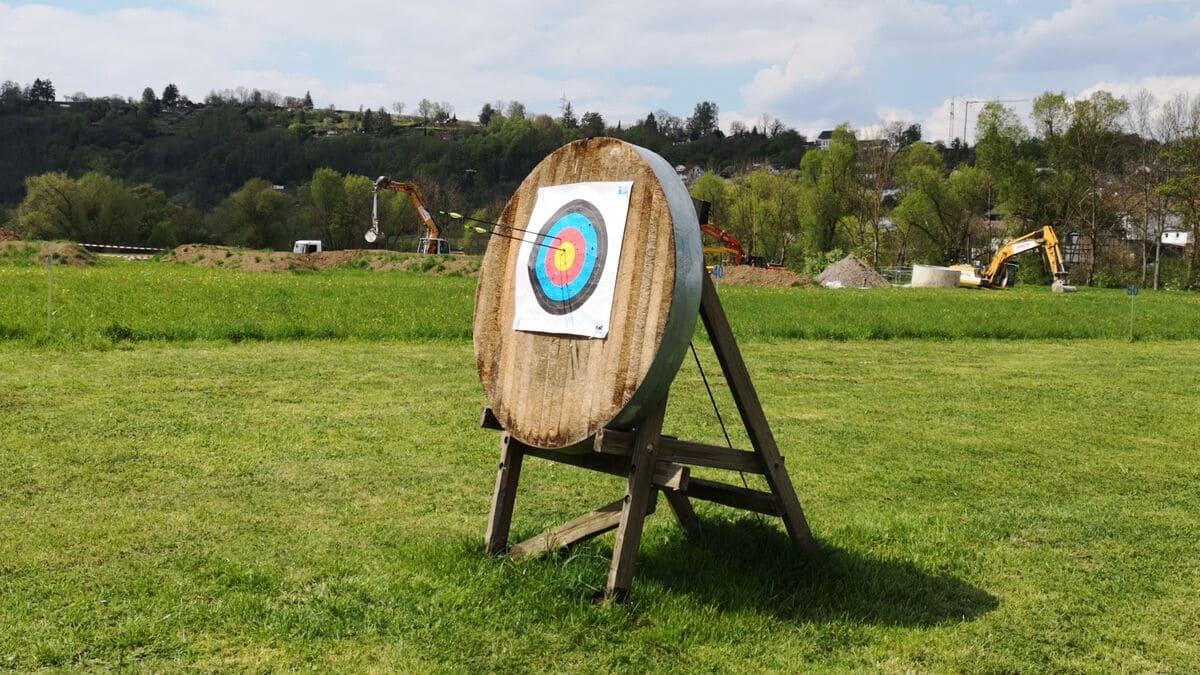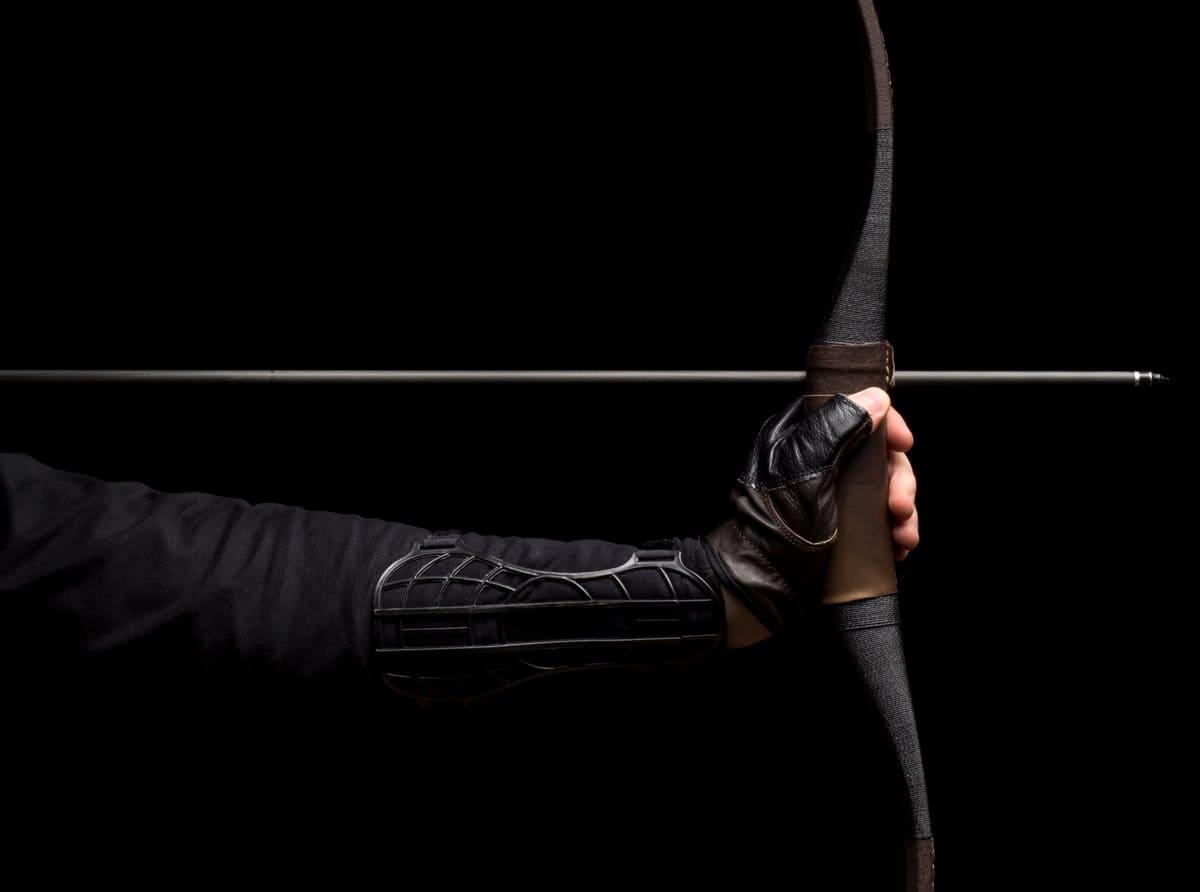Archery 1x1

ARCHERY IN GENERAL
Archery is the ability to shoot arrows with a bow. The English archery comes from the Latin arcus and means "bow". In the past, archery was used for hunting and fighting. It was invented in the Palaeolithic or early Mesolithic. Today it is mainly a competitive and recreational sport. Archery is an important sport in the Olympic programme and is also growing in popularity as a hobby.
Archery works on the principle of a deformable stick (bow) that is tightened with a string. By tensioning the string, the bow appears like a spring and kinetic energy is built up, which is transferred to the arrow as kinetic energy when the string is released. The higher the tension of the bow and the longer the extension of the string, the faster, further, straighter and more powerful the arrow flies. The energy achieved via the tension of the bow is measured as the draw weight on the string in English pounds (1 English pound = 0.453 kg) at a draw of 28 inches (71.12 cm). The draw weight of a bow can range from a few pounds for children's bows to over 60 pounds for trained archers.
Compound bows are equipped with a mechanism similar to a bottle draw. The bow has a much greater draw energy because the draw force applied by the archer is nearly the same from the beginning of the draw until just before full draw, and therefore much greater energy is imposed on the arrow. The length of the draw depends on the length of the shooter's arm and the type of shooting technique. This depends mainly on the anchor point at which the draw hand reaches the greatest extension of the string.
Organisations
The only international association for archery currently recognised by the International Olympic Committee is the World Archery Federation (WA).
The federations in Germany are the DSB, DFBV and DBSV. These differ in terms of styles and age groups. Details are explained in the respective sport regulations of the federation.
Styles / Disciplines
Archery consists of different styles. According to this, the different scoring classes are also formed at the tournaments. The styles are then further subdivided into the various age groups - pupils, youth, archery class, old age class, seniors - and into the genders (archery and women's class).
Target archery

Target archery takes place both indoors and outdoors at distances of up to 90 metres using the familiar gold, red, blue, black and white rings. Target archery combines all the skills of strength, precision and consistency at the Olympic Games and the World Championships. The World Archery Championships, both indoor and outdoor, and the Youth Archery Championships are held every 2 years.
Para Archery
Para archery indoor and outdoor competitions are target archery competitions for athletes with disabilities that classify them for one of World Archery's para-athlete categories: open, W1 and visually impaired. Archery was introduced at the first Paralympic Games in 1960. Since then, it has been included in every Para-Olympics. The World Archery Para Championships are also held every 2 years.
Field Archery
Field archery is often compared to golf as athletes run a course of targets that revolve around an open area, often in the countryside, in forests or around mountains and usually on targets of black and gold. The discipline requires some additional skills, such as shooting uphill and downhill over slopes and judging distances. Field archery is present in the World Games. The World Archery Championships are held every 2 years.
3D Archery
Similar to field archery, 3D archery courses are contested in open ranges where archers shoot at foam targets of different sizes and shapes, usually animal replicas. The World Archery 3D Championships are held every 2 years.
Archery
Archery is a discipline in archery that combines running with archery. It is similar to the biathlon.
Discipline by type of bow
Many of the above-mentioned archery disciplines can be contested with the types of bows listed below.
The recurve bow (Olympic bow)

The Olympic bow is always a recurve bow, recognisable by the fact that the tips of the limbs are bent forward. This is what distinguishes the recurve bow from the longbow and is also what gives it its special energy. The newer and more modern materials make the recurve bow, as an "Olympic bow", the absolutely ideal bow for beginners.
The recurve bow may have more technical equipment than a blank bow. This includes a sighting device, possibly a kisser, a clicker and a stabilisation system. With the recurve bow, the limbs can be exchanged, and thus the power of the bow can be adjusted to the archer. While a tournament bow often has 40 pounds or lbs on the string, a beginner's bow for women should be around 18 - 26 pounds and for men around 24 - 30 pounds.
The cost of a recurve bow ranges from 100 to 1,500 Euros (a good tournament bow). If you are a beginner, you should look for a club and borrow a bow. If you don't have a club nearby, you can buy a centrepiece of your choice and then borrow/rent limbs from your local bow shop. This way you can increase the performance of your limbs step by step without having to spend a lot of money straight away.
The recurve bow allows precision shots at very long distances. Women can reach distances of up to 70 m and men up to 90 m with training and diligence, and their target is the size of a CD case.
The compound bow

The compound bow is a precision bow that achieves a good score very quickly if it is well controlled by the archer.
The compound bow is characterised by the attached pulleys. These mean that the archer no longer has to hold the high draw weight of the string at full draw. While a recurve archer with a 40-pound throwing arm also has about 40 pounds on his fingers, the compound archer with a full 60-pound draw weight only has about 20 pounds on his finger (is adjustable here and depends on the draw length, the size and the shape of the cams). This gives the compound archer a huge advantage and greater ease as he can aim with less effort.
The compound bow achieves by far the highest arrow speed. Speeds of over 300 km/h are no problem here. The speed for a recurve bow, for example, is between 150 km/h and 240 km/h, depending on the draw weight. Due to the high arrow speed, the compound bow achieves a very straight arrow flight path. This means that the arrows land faster and more precisely on target. They are also not as susceptible to wind and rain. Likewise, the compound bow can shoot heavier arrows with a heavier weight, which also brings advantages.
Even as a beginner, a compound bow costs from around 500 euros and more. But unlike the recurve bow, which you can buy bit by bit, here the investment has to be made all at once.
This bow is adjusted to the archer. This means that there are hardly any height deviations in the hit position. In addition, magnifying glasses in the sight (scope) and a spirit level are standard, so that there are no more lateral deviations of the arrows. All this assumes, however, that the shooter already knows how to handle the sporting equipment to some extent.
Good results can be achieved relatively quickly with the compound bow. It is quite common to hit almost only gold. The performance density at tournaments is therefore very high, often only one ring difference decides or even who has shot the highest number of high rings.
The compound bow and the Olympic recurve bow are very popular. For example, high prize money is now being offered in America. And what starts in America usually spreads quickly. So far, there is no such trend for longbows or blank bows. But there are also tournaments for traditional shooting like longbow and blankbow, especially in Germany, Austria and Switzerland.
The longbow

The longbow is probably the most traditional of all bows. A simple stick made of wood and a string - to put it primitively - and you are ready to shoot.
The longbow has no sighting devices and may only be shot with wooden arrows in tournaments, so it is very traditional. The longbow is relatively inexpensive and can be bought for as little as 50 to 150 euros. The longbow can be set up quickly and easily and is ready to shoot in a few seconds.
The longbow is not necessarily suitable for beginners, as it usually has quite a high draw, cannot be finely adjusted and the draw weight increases greatly with greater extension of the bowstring. A beginner's longbow has a draw weight of about 30 pounds, while an advanced bow has a draw weight of 40 or even 65 pounds.
The range of the longbow (we mean the hitting and not the maximum flying distance) is in the range of up to about 30 metres. Very good archers can hit up to 50 m with the longbow. But it is not a precision bow - if you can hit the target at 50 m, you are already a good archer. Shooting is still very intuitive, i.e. by feel.
The German Archery Association does not have a separate starting class for the longbow. It is judged in the tournament together with the much more precise blank bow. However, the other two federations (DFBV and DSBV) also hold separate championships for the longbow.
The blank bow
The blank bow is a recurve bow (the tips of the limbs of a recurve bow are bent away from the archer, the string rests on the limbs, which makes the recurve bow seem about 30% more efficient than the longbow). The blank bow has an arrow rest, a button and also a nocking point. Stabilisers are also allowed. The blank bow may not have a sighting device.
Clothing for archery
In general, and regardless of the type of bow being shot, it is always advisable to wear relatively tight-fitting clothing when shooting. This applies to outerwear such as T-shirts, shirts, polos, jackets, jumpers, pullovers, hoodies as well as trousers. Sturdy and well-fitting, but also weatherproof shoes should be included. Also hats, caps or hats for protection. The individual federations always specify in their competition regulations what clothing may be worn during competitions. In addition, the specialised trade offers a lot of protective accessories, such as arm protectors, chest protectors, gloves, tabs and the like.
Archers Style Always equip yourself with the right, stylish outfit in your free time. Whether shirt, jumper, hoody, jacket or caps.
Here in Wikipedia you can read the whole history of archery.
